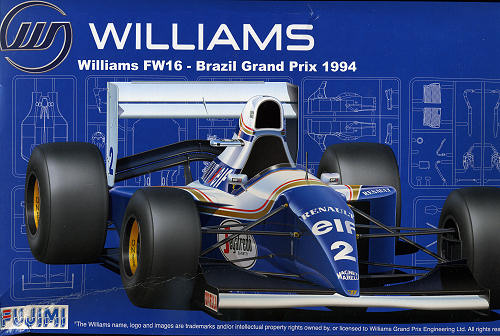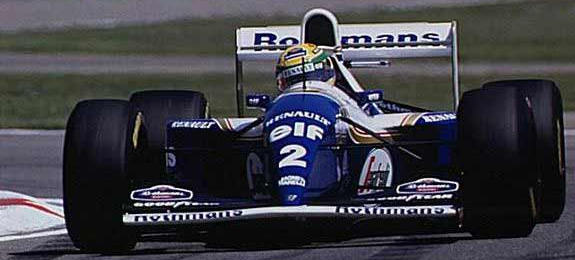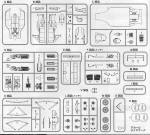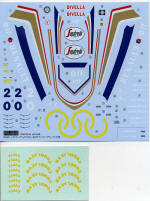
Fujimi 1/20 Williams FW 16 (Brazilian GP 1994)
| KIT #: | 090597 |
| PRICE: | $59.95 |
| DECALS: | Two options |
| REVIEWER: | Scott Van Aken |
| NOTES: |

| HISTORY |
The Williams FW16 was a Formula One car used by the Williams team for the 1994 Formula One season. It was designed by Adrian Newey with the major regulation changes that the FIA had introduced in the off-season, banning the electronic devices that had been used by the front running cars during the preceding two seasons.
The FW16 was a passive evolution of the FW15C that had
preceded it. It featured revised bodywork, with a low profile engine cover and
enclosed driveshaft and an anhedral rear wing lower element, the latter being
hinted at in the preceding FW15C. In addition to these changes it
 featured
an innovative rear suspension wishbone design and an improved version of the
Renault Sport Formula One engine (RS6). In addition it featured a fuel valve to
enable the ability for mid race refuelling.
featured
an innovative rear suspension wishbone design and an improved version of the
Renault Sport Formula One engine (RS6). In addition it featured a fuel valve to
enable the ability for mid race refuelling.
The number 0 car was driven by Damon Hill for the entire season. The number 2 car was driven by Ayrton Senna, David Coulthard and Nigel Mansell. The car proved to be a tricky proposition in early testing and in the early part of the season. A design flaw was discovered in the car's frontal section before the third race of the season, which was attempted to be remedied for the 1994 San Marino Grand Prix. Various other alterations were made to alleviate the cars handling problems by Adrian Newey and Patrick Head. Ultimately the FW16 would be known as the car Ayrton Senna was fatally injured in whilst in the lead of the San Marino Grand Prix.
| THE KIT |
 This
Fujimi kit of the Williams FW16 is one of their superlative 1/20 Formula One
offerings. For those not into racing cars, it seems that 1/20 has become an
industry standard for open wheel F.1 cars with the Japanese leading the way.
Fujimi, Tamiya and Hasegawa all offer F.1 cars to this scale, sometimes
duplicating efforts.
This
Fujimi kit of the Williams FW16 is one of their superlative 1/20 Formula One
offerings. For those not into racing cars, it seems that 1/20 has become an
industry standard for open wheel F.1 cars with the Japanese leading the way.
Fujimi, Tamiya and Hasegawa all offer F.1 cars to this scale, sometimes
duplicating efforts.
Fujimi has molded their car in three basic colors;
white, black and aluminum plate. In this way,
it is felt that the builder will have less painting to do, though most modelers
I know, will go ahead and paint the parts anyway as bare plastic looks like bare
plastic regardless of the color. There are few curbsides in the open wheel model
ranks and this one is no exception with a beautifully detailed Renault engine
and transmission assembly. The cockpit is fully detailed and unlike the previous
boxing, there are no
belts with etched hardware, so you'll have to use aftermarket for that. Rubber or vinyl tires are included and Fujimi has
added a set of tire decals. These look to be either dry transfers or they are
the type that one puts in place (they are slightly sticky), then adds water to
release them from the backing and adhere the m
to the tires. As the instructions are in Japanese, this part is a bit vague to
me.
m
to the tires. As the instructions are in Japanese, this part is a bit vague to
me.
The car also includes a fully detailed suspension, both front and rear as well as detailed accessory section in the nose. Same goes for the side boxes where all the electronics used by the car is located. All the wheels are held in place by little vinyl hold-backs that are inserted in the brake sections. One simply inserts the stub axles into them and the wheels are held in place.
Instructions are very well drawn, and though in Japanese, one should be able to make out most of the sections needed. The kit includes a set of masks to help with painting, though these are not shown in the instructions. Two cars can be modeled. One is the #0 car of Damon Hill and the other is the #2 car for Ayrton Senna. As cars were constantly evolving from race to race, this kit is specifically for the Brazilian race. There are other boxings for other events. The main difference in this one is the roll bar shape and, of course, the front and rear wings. Decals are superbly done, but are lacking the tobacco sponsors. This is a common feature of race car kits in that they don't provide markings for tobacco or alcohol sponsors. If you compare the box art with the photo, you'll see some of these omissions. Fortunately, Tabu Design offers the missing markings. A set of masks are provided to help with some of the more difficult painting areas. As only Gunze paint references are provided, the main blue shade will have to be mixed.
| CONCLUSIONS |
Overall, another excellent F.1 kit from Fujimi. The kit has all the detail you'll need, and while it will take careful construction, the end result will be a superb replica for your shelves.
| REFERENCES |
http://en.wikipedia.org/wiki/Williams_FW16
November 2010
Thanks to www.dragonmodelsusa.com for the preview kit. Get yours today at your local shop or on-line retailer.
If you would like your product reviewed fairly and quickly, please contact me or see other details in the Note to Contributors.